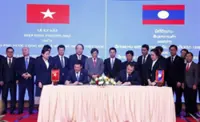A woman incorporates a repeated Naga design into a piece of woven fabric. - Unesco
VIENTIANE: The United Nations Educational, Scientific and Cultural Organisation (Unesco) has designated the Naga motif, which is commonly used by Lao women when weaving ornamental fabrics and traditional skirts, as a form of Intangible Cultural Heritage of Humanity.
Unesco’s recognition of this art form reflects the cultural value of the Lao textiles woven by the women of many of Laos’ ethnic groups, whose weaving designs have been passed down from generation to generation in all parts of the country.
Already a subscriber? Log in
Save 30% OFF The Star Digital Access
Cancel anytime. Ad-free. Unlimited access with perks.





